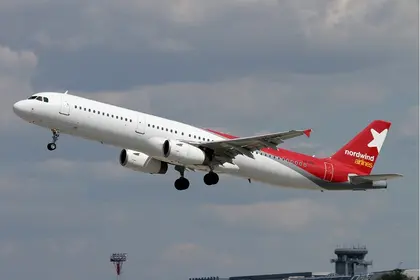Another Russian aviation emergency was identified by Artem Korenyako, a representative of the Federal Air Transport Agency, who reported via Telegram that Nordwind Airlines flight NWS077, an Airbus A321 passenger aircraft sent out a distress signal shortly after taking off from Moscow’s Sheremetyevo International airport on a flight to Orenburg and had to return.
The aircraft departed at 1:27 p.m. Moscow time and was in the air for almost 40 minutes before landing safely at Sheremetyevo at around 3:05 p.m. According to the TASS news agency the flight commander took the decision to return after the cockpit suffered a sudden depressurization while over Arzamas in the Nizhny Novgorod region.
JOIN US ON TELEGRAM
Follow our coverage of the war on the @Kyivpost_official.
Immediately after the emergency occurred the pilot dropped the aircraft from its cruising altitude of around 10,000 meters to 3,000 which caused the aircraft to disappear from radar, which raised immediate concern that a more serious malfunction had occurred, although it reappeared after a short time.
Later reports suggest that depressurisation hadn't actually occurred but faulty sensors onboard the aircraft gave a false reading. Either way it is yet another example of how Russian airlines are struggling to maintain their aircraft.
Kyiv Post has previously reported on the deteriorating state of Russian commercial airlines because of the impact of Western sanctions. According to a February Wall Street Journal article the German research company Jacdec, Russian airlines suffered 74 in flight emergencies in 2023 which was more than double the 2022 number of 36 events. In addition Russia’s Federal Air Transport Agency, recorded more than 400 instances of equipment failure involving engines, landing gear, flaps, aircraft software and hydraulic systems prior to flights.

Rheinmetall to Deliver 155mm Modular Artillery Charges to Ukraine
The Moscow Times, citing Russia’s Air Incident channel reported that the trend in failures had continued into 2024, with ten serious of air incidents occurring in January alone and six instances of in-flight engine failure in the first three months of the year.
Prior to Russia’s full-scale invasion of Ukraine Russian airlines operated over 1,000 aircraft of which almost two-thirds of which were Boeing and Airbus airliners.
Alexander Lanetsky, general director of the Lithuanian aviation consulting company Friendly Avia Support has said that “Sanctions imposed against Russian airlines have made it significantly more difficult to maintain the airworthiness of aircraft and their technical condition.”
While serious damage or disaster has so far been avoided, experts say that the number and range of persistent technical problems increasingly poses significant risks to passengers and aircrew.
Lanetsky feels that these problems are being exacerbated by attempts by Russian airlines to keep their fleets in the air by cannibalization of parts and improvised repair and maintenance programs. He said, “These improvised approaches raise concerns about potential consequences and safety.”
You can also highlight the text and press Ctrl + Enter






